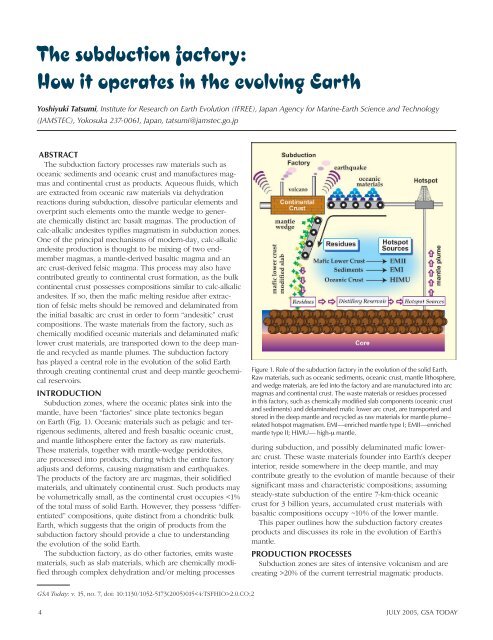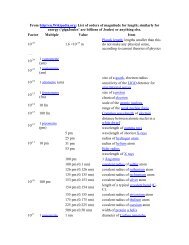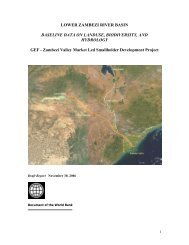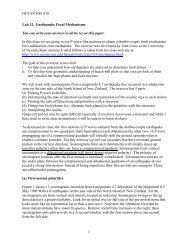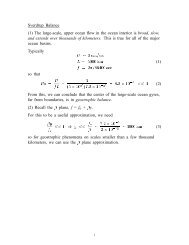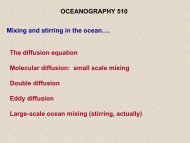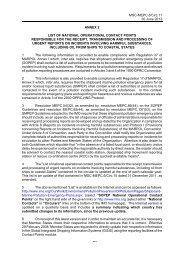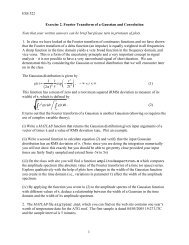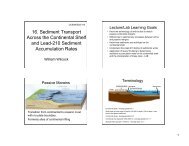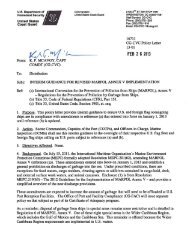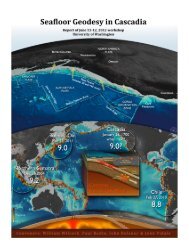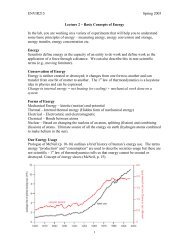The Subduction Factory - Geological Society of America
The Subduction Factory - Geological Society of America
The Subduction Factory - Geological Society of America
You also want an ePaper? Increase the reach of your titles
YUMPU automatically turns print PDFs into web optimized ePapers that Google loves.
<strong>The</strong> subduction factory:<br />
How it operates in the evolving Earth<br />
Yoshiyuki Tatsumi, Institute for Research on Earth Evolution (IFREE), Japan Agency for Marine-Earth Science and Technology<br />
(JAMSTEC), Yokosuka 237-0061, Japan, tatsumi@jamstec.go.jp<br />
ABSTRACT<br />
<strong>The</strong> subduction factory processes raw materials such as<br />
oceanic sediments and oceanic crust and manufactures magmas<br />
and continental crust as products. Aqueous fluids, which<br />
are extracted from oceanic raw materials via dehydration<br />
reactions during subduction, dissolve particular elements and<br />
overprint such elements onto the mantle wedge to generate<br />
chemically distinct arc basalt magmas. <strong>The</strong> production <strong>of</strong><br />
calc-alkalic andesites typifies magmatism in subduction zones.<br />
One <strong>of</strong> the principal mechanisms <strong>of</strong> modern-day, calc-alkalic<br />
andesite production is thought to be mixing <strong>of</strong> two endmember<br />
magmas, a mantle-derived basaltic magma and an<br />
arc crust-derived felsic magma. This process may also have<br />
contributed greatly to continental crust formation, as the bulk<br />
continental crust possesses compositions similar to calc-alkalic<br />
andesites. If so, then the mafic melting residue after extraction<br />
<strong>of</strong> felsic melts should be removed and delaminated from<br />
the initial basaltic arc crust in order to form “andesitic” crust<br />
compositions. <strong>The</strong> waste materials from the factory, such as<br />
chemically modified oceanic materials and delaminated mafic<br />
lower crust materials, are transported down to the deep mantle<br />
and recycled as mantle plumes. <strong>The</strong> subduction factory<br />
has played a central role in the evolution <strong>of</strong> the solid Earth<br />
through creating continental crust and deep mantle geochemical<br />
reservoirs.<br />
INTRODUCTION<br />
<strong>Subduction</strong> zones, where the oceanic plates sink into the<br />
mantle, have been “factories” since plate tectonics began<br />
on Earth (Fig. 1). Oceanic materials such as pelagic and terrigenous<br />
sediments, altered and fresh basaltic oceanic crust,<br />
and mantle lithosphere enter the factory as raw materials.<br />
<strong>The</strong>se materials, together with mantle-wedge peridotites,<br />
are processed into products, during which the entire factory<br />
adjusts and deforms, causing magmatism and earthquakes.<br />
<strong>The</strong> products <strong>of</strong> the factory are arc magmas, their solidified<br />
materials, and ultimately continental crust. Such products may<br />
be volumetrically small, as the continental crust occupies 20% <strong>of</strong> the current terrestrial magmatic products.<br />
GSA Today: v. 15, no. 7, doi: 10:1130/1052-5173(2005)0152.0.CO;2<br />
4 JULY 2005, GSA TODAY
Although the interaction <strong>of</strong> physical and<br />
chemical processes occurring in subduction<br />
zones is complex, arc magmatism<br />
exhibits characteristics common to not<br />
all but most arc-trench systems. One<br />
<strong>of</strong> these general characteristics is the<br />
presence <strong>of</strong> paired lines <strong>of</strong> volcanoes.<br />
Another is the negative correlation<br />
between the volcanic arc width and<br />
the subduction angle (Fig. 2A). In other<br />
words, the depth to the surface <strong>of</strong> the<br />
subducting lithosphere is constant at<br />
~110 km and ~170 km, respectively,<br />
beneath the trenchward limit <strong>of</strong> the<br />
volcanic arc (the volcanic front) and the<br />
backarc-side volcanoes (Fig. 2B). This<br />
characteristic volcano distribution relative<br />
to subduction depth suggests an<br />
important role <strong>of</strong> pressure-dependent<br />
processes such as dehydration reactions<br />
in magma generation in the subarc<br />
mantle. As emphasized by Tatsumi and<br />
Figure 2. Tectonic characteristics <strong>of</strong> subduction<br />
zone magmatism (Tatsumi and Eggins,<br />
1995). (A) Negative correlation between the<br />
subduction angle and the volcanic arc width.<br />
(B) Constant depths to the surface <strong>of</strong> the<br />
subducting lithosphere beneath the trenchside<br />
(volcanic front) and backarc-side volcanic<br />
chains in volcanic arcs. Noted values are the<br />
average depths and one standard deviation.<br />
<strong>The</strong>se observations suggest the primary role <strong>of</strong><br />
pressure-dependent reactions in production <strong>of</strong><br />
arc magmas.<br />
Eggins (1995), the characteristic depths<br />
correspond to pressures expected for<br />
the dehydration <strong>of</strong> amphibole and chlorite<br />
(110 km) and phlogopite (170 km) in<br />
the hydrous peridotite layer at the base<br />
<strong>of</strong> the mantle wedge, which is formed by<br />
addition <strong>of</strong> slab-derived aqueous fluids<br />
beneath the forearc and dragged downward<br />
on the subducting plate.<br />
Within any volcanic arc, lava chemistry<br />
tends to change systematically with<br />
distance from the volcanic front. <strong>The</strong><br />
degree <strong>of</strong> silica saturation decreases<br />
toward the backarc (Kuno, 1966) with<br />
increasing concentrations <strong>of</strong> incompatible<br />
elements such as K, Rb, and Zr, a<br />
relationship known as the K-h (K, potassium;<br />
h, height above the slab) relationship<br />
(Dickinson, 1975). A possible<br />
origin <strong>of</strong> this observation is separation<br />
<strong>of</strong> a primary magma from an adiabatically<br />
rising mantle diapir at a greater<br />
depth by a lower degree <strong>of</strong> partial melting<br />
toward the backarc, which may be<br />
caused by the presence <strong>of</strong> a thicker<br />
lithosphere beneath the backarc side <strong>of</strong><br />
a volcanic arc (e.g., Tatsumi et al., 1983;<br />
Zhao et al., 1992; Furukawa, 1993).<br />
Selective enrichment <strong>of</strong> particular<br />
incompatible elements in arc basalts has<br />
been well established since the pioneer<br />
work by Pearce and Cann (1973). This<br />
can be intuitively attributed to addition <strong>of</strong><br />
the slab-derived component to the original<br />
mantle wedge. Herein the geochemical<br />
characteristics <strong>of</strong> arc magmas and<br />
their possible causes including element<br />
transport from the downgoing oceanic<br />
lithosphere will be further outlined.<br />
Basaltic Magma<br />
Although basalts are not always the<br />
major surface products <strong>of</strong> the subduction<br />
factory, magmas generated in the<br />
mantle wedge are likely to be basaltic<br />
in composition. Basalts erupted in<br />
subduction zones are noted for their<br />
distinct chemistry compared with those<br />
in other tectonic settings. In particular,<br />
they are elevated in large ion lithophile<br />
elements (e.g., Cs, Rb, K, Ba, Pb, Sr)<br />
and depleted in high field strength elements<br />
(e.g., Ta, Nb, Zr, Ti) (Fig. 3). Such<br />
characteristic compositions likely arise<br />
from subducting oceanic lithosphere<br />
through metasomatic reactions between<br />
the subducting lithosphere and the<br />
overlying mantle wedge. What is the<br />
nature <strong>of</strong> the metasomatic process that<br />
Figure 3. Normal mid-oceanic-ridge basalt (N-<br />
MORB)-normalized (Sun and McDonough,<br />
1989) incompatible element characteristics<br />
<strong>of</strong> arc basalts (Tatsumi and Eggins, 1995), an<br />
arc basalt magma inferred from geochemical<br />
modeling on element transport by dehydration<br />
<strong>of</strong> subducting sediments and altered oceanic<br />
crust (Tatsumi and Kogiso, 2003), and a<br />
hotspot-related oceanic-island basalt (Sun and<br />
McDonough, 1989).<br />
enriches the source region <strong>of</strong> subduction<br />
zone magmas Since the work <strong>of</strong><br />
Nicholls and Ringwood (1973), many<br />
petrologists have favored mechanisms<br />
including slab melting and subsequent<br />
melt-mantle interaction. A majority <strong>of</strong><br />
researchers, however, currently believe<br />
that the subducting lithosphere dehydrates<br />
but does not melt except in arctrench<br />
systems where a young and hot<br />
plate is being subducted (Peacock et al.,<br />
1994). During the Archean, however,<br />
temperatures <strong>of</strong> both the upper mantle<br />
and the subducting crust might have<br />
been higher, which could cause slab<br />
melting, rather than slab dehydration<br />
(Martin, 1987). This possibility will be<br />
discussed later.<br />
Under upper mantle P-T conditions,<br />
H 2 O exists as a supercritical fluid, which<br />
can dissolve additional components and<br />
elements to a certain extent. <strong>The</strong>refore,<br />
aqueous fluid phases released by dehydration<br />
reactions within the subducting<br />
lithosphere may be a likely metasomatic<br />
agent responsible for the characteristic<br />
trace element signatures. To elucidate<br />
the geochemical characteristics <strong>of</strong> such<br />
slab-derived fluid phases, several experimental<br />
studies have been conducted<br />
on the distribution <strong>of</strong> elements between<br />
aqueous fluids and solid minerals (e.g.,<br />
Tatsumi et al., 1986; Brenan et al., 1995;<br />
Keppler, 1996). On the basis <strong>of</strong> these<br />
experimental data, together with reasonable<br />
assumptions <strong>of</strong> H 2 O contents<br />
(1.5 wt%) in both subducting oceanic<br />
GSA TODAY, JULY 2005 5
materials and arc magmas, the preflux<br />
and original subarc mantle compositions<br />
(normal mid-oceanic-ridge basalt<br />
source), Tatsumi and Kogiso (2003)<br />
demonstrated that the geochemical<br />
characteristics <strong>of</strong> arc basalts could be<br />
reasonably explained by addition <strong>of</strong><br />
elements from subducting sediments<br />
and oceanic crust through dehydration<br />
processes (Fig. 3). On the other hand,<br />
Elliott et al. (1997) suggested that slabderived<br />
melts are one possible medium<br />
for modifying the mantle wedge so as<br />
to make potential sources for some<br />
basaltic magmas even in the Mariana arc<br />
where subduction <strong>of</strong> the oldest oceanic<br />
lithosphere on Earth causes arc magmatism.<br />
Miscibility between silicate melts<br />
and hydrous fluids under upper mantle<br />
conditions (e.g., Bureau and Keppler,<br />
1999) could explain the complex metasomatic<br />
agents in subduction zones as<br />
products <strong>of</strong> both melting and dehydration.<br />
If element transport by slab-derived<br />
fluid phases could be accepted as one<br />
major process responsible for the distinctive<br />
chemistry <strong>of</strong> arc basalt magmas,<br />
then the fate <strong>of</strong> dehydrated and chemically<br />
modified residues (both sediments<br />
and basalts), especially their role in the<br />
mantle evolution, should be equally<br />
interesting.<br />
Andesitic Magma<br />
Andesite erupts in >80% <strong>of</strong> arc volcanoes,<br />
typifies magmatism in subduction<br />
zones, and is the most dominant volcanic<br />
rock in mature continental arcs. In<br />
addition to this volumetric importance,<br />
the continental crust, the geochemical<br />
reservoir for light elements and<br />
the most differentiated end-member<br />
among components within the solid<br />
Earth, is <strong>of</strong> overall andesitic composition<br />
(e.g., Taylor, 1995; Rudnick, 1995).<br />
Knowledge <strong>of</strong> andesite genesis should<br />
therefore provide key constraints on<br />
the origin <strong>of</strong> continental crust and differentiation<br />
processes during early Earth<br />
evolution.<br />
Although andesite is defined simply<br />
as sub-alkalic, intermediate volcanic<br />
rock, its origin is not unique. Two<br />
distinctive differentiation trends, tholeiitic<br />
(TH) and calc-alkalic (CA), are<br />
recognized in the andesitic volcanic<br />
rocks <strong>of</strong> arcs, denoting the presence<br />
or absence <strong>of</strong> relative iron-enrichment<br />
Figure 4. Major element characteristics for<br />
calc-alkalic (CA) and tholeiitic (TH) rocks from<br />
NE Japan (NEJ) arc and the bulk continental<br />
crust (data from Tatsumi and Kogiso, 2003). (A)<br />
CA and TH trends generally have steeper and<br />
gentler slopes, respectively, than the straight<br />
line in a SiO 2 versus FeO*/MgO diagram<br />
(Miyashiro, 1974). (B) While TH rocks tend to<br />
show a concave trend in a SiO 2 versus MgO<br />
diagram, CA rocks exhibit a rather straight<br />
trend. Solid and broken lines with arrows<br />
indicate the liquid lines <strong>of</strong> descent obtained<br />
by experiments at 0.2 GPa by Grove and<br />
coworkers (e.g., Sisson and Grove, 1993; Grove<br />
et al., 2003) and MELTS calculation (see text).<br />
Mixing <strong>of</strong> basaltic and felsic magmas (filled and<br />
open stars in Fig. 4B) can explain a rather linear<br />
trend for CA series rocks.<br />
during magmatic differentiation (Wager<br />
and Deer, 1939). FeO*/MgO versus SiO 2<br />
variation plots (FeO*, total iron as FeO)<br />
(Miyashiro, 1974) are commonly used<br />
to distinguish the two magma series<br />
(Fig. 4A); CA and TH trends generally<br />
have steeper and gentler slopes,<br />
respectively, than the straight line in<br />
Figure 4A. Although the definition <strong>of</strong><br />
CA versus TH should be based exclusively<br />
on differences in degree <strong>of</strong> relative<br />
iron enrichment, inconsistent usage<br />
<strong>of</strong> these magma series has in the past<br />
caused confusion. One such example<br />
is the interchangeable use <strong>of</strong> the terms<br />
medium-K and CA series (e.g., Hess<br />
1989). Another problem is the application<br />
<strong>of</strong> Miyashiro’s discrimination line<br />
as a simple compositional discriminant<br />
rather than applying a more desirable<br />
“trend slope” comparison (e.g., Hunter<br />
and Blake, 1995).<br />
One <strong>of</strong> the most distinct chemical<br />
differences between CA and TH series<br />
rocks, other than the difference in<br />
degree <strong>of</strong> iron-enrichment, is the characteristic<br />
differentiation trend <strong>of</strong> MgO<br />
versus SiO 2 (Fig. 4B); while TH rocks<br />
tend to show a concave trend, CA rocks<br />
exhibit a straighter trend. It is generally<br />
accepted that the TH differentiation<br />
trend can be largely reproduced by<br />
fractionation <strong>of</strong> phenocryst phases such<br />
as olivine, plagioclase, and pyroxene<br />
from a parental basaltic magma (e.g.,<br />
Sakuyama, 1981; Grove and Baker,<br />
1984; Fujinawa 1988), which is also supported<br />
by MELTS modeling (Ghiorso<br />
and Sack, 1995) for a basaltic magma in<br />
the presence <strong>of</strong> 0.5 wt% H 2 O at 0.2 GPa<br />
under a quartz-fayalite-magnetite (QFM)<br />
buffer (Fig. 4).<br />
On the other hand, the genesis <strong>of</strong> CA<br />
andesites poses a considerable question<br />
for debate. One possible cause for<br />
the characteristic CA trend is the effective<br />
separation <strong>of</strong> Fe-Ti oxide that can<br />
prevent iron enrichment (e.g., Osborn,<br />
1959; Gill, 1981). Grove and coworkers<br />
(e.g., Sisson and Grove, 1993; Grove<br />
et al., 2003) provided a comprehensive<br />
experimental data set <strong>of</strong> liquid lines <strong>of</strong><br />
descent for basaltic and andesitic magmas<br />
under hydrous conditions, demonstrating<br />
that a high magmatic H 2 O<br />
content reduces the stability <strong>of</strong> silicate<br />
minerals. This has less effect on Fe-Ti<br />
oxide stability, resulting in early magnetite<br />
crystallization in hydrous magmas.<br />
It is thus likely that hydrous basalt, and<br />
even mantle-derived andesitic magmas,<br />
can fractionate to form a CA trend (Fig.<br />
4). If this is the case, then the primary<br />
factor controlling the production <strong>of</strong> the<br />
two arc magma series is the H 2 O content<br />
in the magma source region (i.e.,<br />
more hydrous for CA magma generation).<br />
However, this elegant explanation<br />
may not account for the observation<br />
that CA andesites commonly exhibit the<br />
following disequilibrium petrographic<br />
characteristics, which suggest a role<br />
for magma mixing in their formation<br />
(Eichelberger, 1975; Sakuyama, 1981;<br />
Bloomfield and Arculus, 1989; Clynne,<br />
6 JULY 2005, GSA TODAY
1999): (1) the presence <strong>of</strong> plagioclase<br />
phenocrysts with a dusty zone containing<br />
fine melt inclusions and with a wide<br />
range <strong>of</strong> compositions; (2) the presence<br />
<strong>of</strong> reversely zoned pyroxene phenocrysts<br />
with rounded cores mantled by<br />
rims with higher Mg/Fe ratios; (3) the<br />
presence <strong>of</strong> subhedral to rounded olivine<br />
phenocrysts rimmed by pyroxene;<br />
and (4) the occurrence <strong>of</strong> disequilibrium<br />
mineral assemblages such as Mg-rich olivine<br />
and quartz. Mixing <strong>of</strong> mafic and felsic<br />
end-member magmas can form linear<br />
trends on variation diagrams (Fig. 4).<br />
If we accept magma mixing as one<br />
possible mechanism responsible for<br />
the petrographic and chemical characteristics<br />
<strong>of</strong> CA andesites, then an<br />
ensuing question involves the origin<br />
<strong>of</strong> end-member components in magmas,<br />
one basaltic and formed at higher<br />
T, the other more differentiated and<br />
formed at lower T. A key observation<br />
in this problem is a systematic difference<br />
in isotopic composition between<br />
CA and TH series rocks, as documented<br />
at least in some Quaternary volcanoes<br />
in the NE Japan arc (Fujinawa,<br />
1988; Tatsumi and Kogiso, 2003). If<br />
this observation may be generalized to<br />
other arcs, then the two end-member<br />
magmas could be derived from different<br />
sources. <strong>The</strong>refore, “self mixing”<br />
(Couch et al., 2001) or “internal mixing,”<br />
in which felsic and mafic magmas<br />
are essentially co-magmatic, does not<br />
likely play a major role in CA andesite<br />
formation. Alternatively, a felsic endmember<br />
magma could form by anatexis<br />
<strong>of</strong> preexisting arc crust and mix with a<br />
mantle-derived basaltic magma, which<br />
may be considered “external mixing.”<br />
Furthermore, the origin <strong>of</strong> the basaltic<br />
end-member magma is still a matter<br />
<strong>of</strong> debate. Is it a TH basalt Or, does<br />
a mantle-derived CA basalt exist To<br />
improve our understanding <strong>of</strong> andesite<br />
genesis, detailed descriptions <strong>of</strong> the two<br />
magma series rocks from a single volcano<br />
are needed.<br />
Continental Crust Formation<br />
<strong>The</strong> continental crust has an average<br />
composition equivalent to CA andesites<br />
(Fig. 4) that typify arc magmatism and<br />
hence is believed to be created at convergent<br />
plate margins (e.g., Kelemen,<br />
1995; Taylor, 1995; Rudnick, 1995).<br />
However, modern-day, mantle-derived<br />
magmatism in such settings is dominated<br />
by basalt. This dilemma faces<br />
anyone interested in the theory <strong>of</strong> continental<br />
crust formation. Herein, possible<br />
alternative solutions are considered: (a)<br />
direct production <strong>of</strong> andesitic magmas,<br />
and (b) mechanical fractionation <strong>of</strong> basaltic<br />
arc crust to remove the mafic part.<br />
<strong>The</strong> majority <strong>of</strong> continental crust was<br />
created in the Archean, when the geotherm<br />
was steeper and hotter, and it<br />
is possible that Archean slab melting,<br />
instead <strong>of</strong> slab dehydration as at present,<br />
could have been responsible for<br />
production <strong>of</strong> dominantly andesitic as<br />
opposed to basaltic magmas (Shirey and<br />
Hanson, 1984; Martin, 1987; Drummond<br />
and Defant, 1990; Kelemen, 1995; Rapp<br />
et al., 1999). High-P experiments (Rapp et<br />
al., 1999) demonstrated that slab melting<br />
and subsequent interaction <strong>of</strong> Si-rich slabmelt<br />
with Mg-rich mantle can reproduce<br />
andesitic compositions similar to the continental<br />
crust. Modeling based on geochemical<br />
formulation <strong>of</strong> partial melting<br />
and melt-solid reactions (Tatsumi, 2000a)<br />
Figure 5. Normal mid-oceanic-ridge basalt (N-<br />
MORB)-normalized (Sun and McDonough, 1989)<br />
incompatible element characteristics <strong>of</strong> the bulk<br />
continental crust (Taylor, 1995; Rudnick, 1995) and<br />
modeled inferred andesite magmas. (A) Andesitic<br />
magmas are assumed to be produced by slab<br />
melting under three representative P-T conditions<br />
(eclogite, amphibolite, and granulite facies) and<br />
subsequent melt-mantle interactions (Tatsumi,<br />
2000a). (B) An andesitic magma is produced by<br />
mixing between a basalt magma produced by<br />
slab dehydration induced by mantle melting and<br />
a felsic magma formed by remelting <strong>of</strong> the initial<br />
basaltic arc crust (Tatsumi and Kogiso, 2003).<br />
has confirmed that this mechanism can<br />
also account for trace element characteristics<br />
<strong>of</strong> bulk andesitic continental crust<br />
(Fig. 5A).<br />
Alternatively, an andesitic magma<br />
having compositions similar to the bulk<br />
continental crust can be also produced<br />
by mixing <strong>of</strong> a basaltic magma generated<br />
by mantle melting induced by<br />
slab dehydration with a felsic magma<br />
produced by partial melting <strong>of</strong> the initial<br />
basaltic arc crust, as geochemically<br />
modeled by Tatsumi and Kogiso (2003)<br />
(Fig. 5B). This process <strong>of</strong> andesitic crust<br />
formation is identical to that envisioned<br />
for CA andesite production operating in<br />
current subduction zones. Although this<br />
mixing process can create the andesitic<br />
crust, the composition <strong>of</strong> the total crust<br />
is still basaltic, not andesitic. In order<br />
to make an andesitic continental crust,<br />
therefore, the mafic lower crust, which<br />
is a melting residue after segregation<br />
<strong>of</strong> felsic magma, should be extracted<br />
from the arc crust. One possible extraction<br />
mechanism would be delamination<br />
<strong>of</strong> the lower part <strong>of</strong> initial basaltic arc<br />
crust, because the melting residue may<br />
be composed <strong>of</strong> mafic rocks, containing<br />
dense minerals such as garnet and Fe-<br />
Ti oxides, that ultimately sink into the<br />
mantle (Turcotte, 1989; Kay and Kay,<br />
1993; Nakajima and Arima, 1998; Jull<br />
and Kelemen, 2001).<br />
In summary, the major and incompatible<br />
trace element characteristics<br />
<strong>of</strong> andesitic bulk continental crust can<br />
be explained by either slab melting or<br />
by magma mixing in association with<br />
delamination <strong>of</strong> mafic lower crust.<br />
However, waste materials after processing<br />
are different for the two mechanisms:<br />
melting residue <strong>of</strong> basaltic oceanic<br />
crust at mantle pressures and that<br />
<strong>of</strong> basaltic arc crust at crust pressures<br />
for the slab melting and delamination,<br />
respectively. This difference will be further<br />
examined isotopically in the following<br />
section.<br />
RECYCLING PROCESSES<br />
Surface materials such as crust and<br />
sediments, from which certain components<br />
are extracted during subduction,<br />
are injected into the mantle, resulting<br />
in significant chemical heterogeneity in<br />
the deep mantle. Although the physical<br />
properties <strong>of</strong> descending surficial and<br />
mantle materials have been investigated<br />
GSA TODAY, JULY 2005 7
at high pressures (e.g., Ringwood,<br />
1991; Ono et al., 2001; Guignot and<br />
Andrault, 2004), the location in the<br />
mantle where subduction components<br />
are stored is still beyond consensus.<br />
It has been suggested from geochemical<br />
studies on mid-oceanic-ridge<br />
basalts (MORBs) and oceanic-island<br />
basalts (OIBs) that at least four endmember<br />
components or geochemical<br />
reservoirs in addition to primitive<br />
mantle are needed to explain the<br />
isotopic diversity <strong>of</strong> oceanic basalts<br />
(e.g., Zindler and Hart, 1986; H<strong>of</strong>mann,<br />
1997): depleted MORB mantle (DMM),<br />
enriched mantle types I and II (EMI<br />
and EMII), and high-μ mantle (HIMU).<br />
It is generally believed that DMM, with<br />
its distinct isotopically depleted signature,<br />
occupies the shallowest upper<br />
mantle, whereas other enriched mantle<br />
components typify magmas rising from<br />
deep-seated hotspots. It may therefore<br />
be illuminating to discuss linkages<br />
among three enriched geochemical<br />
end-members in the deep mantle and<br />
waste materials generated in the subduction<br />
factory such as sediment, oceanic<br />
crust, and possibly delaminated<br />
mafic lower crust.<br />
Dehydrated Oceanic Crust and<br />
HIMU<br />
<strong>The</strong> HIMU, or high-μ (μ = 238 U/ 204 Pb),<br />
source is characterized by higher<br />
206 Pb/ 204 Pb and 187 Os/ 186 Os, but<br />
depleted MORB-like 87 Sr/ 86 Sr and<br />
143 Nd/ 144 Nd compared to other endmember<br />
components (Zindler and<br />
Hart, 1986; Hauri and Hart, 1993).<br />
<strong>The</strong>se isotopic signatures, particularly<br />
high 206 Pb/ 204 Pb, have been generally<br />
considered to be related to depletion<br />
<strong>of</strong> Pb relative to U by dehydration<br />
processes in subduction zones (e.g.,<br />
Chauvel et al., 1992; Brenan et al.,<br />
1995; Kogiso et al., 1997). Because Nd<br />
is extracted from subducting altered<br />
oceanic crust more readily than Sm<br />
(Keppler, 1996; Kogiso et al., 1997),<br />
ancient residual dehydrated oceanic<br />
crust has higher 143 Nd/ 144 Nd than the<br />
HIMU component (Fig. 6A), suggesting<br />
that HIMU cannot be created solely<br />
by the contribution <strong>of</strong> dehydrated<br />
subducting crust. Instead, Tatsumi and<br />
Kogiso (2003) demonstrated that isotopic<br />
signatures <strong>of</strong> HIMU could be reasonably<br />
explained by accumulation <strong>of</strong><br />
Figure 6. Isotopic compositions <strong>of</strong> inferred waste materials from the subduction factory (dehydrated/fresh<br />
oceanic crust, Tatsumi and Kogiso, 2003; dehydrated sediment, Aizawa et al., 1999; delaminated mafic<br />
lower crust, Tatsumi and Kogiso, 2003) and mantle geochemical reservoirs (DMM—depleted mid-oceanicridge<br />
basalt mantle; HIMU—high-μ mantle; EMI—enriched mantle type I; EMII—enriched mantle type II;<br />
MORB—mid-oceanic-ridge basalt; PM—primitive mantle) that have been proposed to explain the isotopic<br />
diversity observed for ocean island basalts. Evolution <strong>of</strong> deep mantle reservoirs may be comprehensively<br />
explained by contribution <strong>of</strong> recycled waste materials from the subduction factory and primitive mantle.<br />
Figure 7. <strong>The</strong> isotopic evolution <strong>of</strong> the slab restites produced after extraction <strong>of</strong> slab melts at three<br />
representative P-T conditions (eclogite, amphibolite, and granulite facies; Tatsumi 2000b) and fresh midoceanic-ridge<br />
basalt (MORB) (Tatsumi and Kogiso, 2003), with ages <strong>of</strong> formation. Isotopic compositions<br />
<strong>of</strong> mantle geochemical reservoirs (DMM—depleted MORB mantle; HIMU—high-μ mantle; EMI—<br />
enriched mantle type I; EMII—enriched mantle type II; and PM—primitive mantle) are also shown. Mixing<br />
<strong>of</strong> slab restites with fresh MORB and/or PM cannot explain the geochemical characteristics <strong>of</strong> enriched<br />
geochemical reservoirs such as EMI, EMII, and HIMU.<br />
8 JULY 2005, GSA TODAY
oth 2 Ga fresh and dehydrated MORB<br />
crust in the deep mantle (Fig. 6).<br />
Dehydrated Sediment and EMII<br />
<strong>The</strong> role <strong>of</strong> subducting sediments<br />
in the evolution <strong>of</strong> EMII is commonly<br />
advocated, because oceanic sediments<br />
generally have high 87 Sr/ 86 Sr and relatively<br />
low 143 Nd/ 144 Nd (e.g., Devey et<br />
al., 1990). Experimental results on<br />
sediment dehydration and associated<br />
element transport (Aizawa et al., 1999;<br />
Johnson and Plank, 1999) have demonstrated<br />
that chemically modified,<br />
dehydrated ancient subducted oceanic<br />
sediments, a waste material from the<br />
subduction factory, may evolve to<br />
an enriched component having high<br />
87 Sr/ 86 Sr and 206 Pb/ 204 Pb. Aizawa et al.<br />
(1999) further suggest that the isotopic<br />
signature <strong>of</strong> the EMII component can<br />
be achieved by the addition <strong>of</strong> small<br />
amounts (~1 wt%) <strong>of</strong> 1 Ga dehydrated<br />
sediments to primitive mantle (Fig. 6).<br />
Melting Residue <strong>of</strong> Sinking Oceanic<br />
Crust<br />
Partial melting <strong>of</strong> the sinking basaltic<br />
oceanic crust may have taken place<br />
more widely during Earth’s early history<br />
and could have contributed to<br />
continental crust formation. If this is the<br />
case, then the restites <strong>of</strong> slab melting,<br />
with compositions distinct from the bulk<br />
mantle, may have formed a geochemical<br />
reservoir in the deep mantle and<br />
could have been recycled as a hotspot<br />
source. Figure 7 shows the Sr-Nd isotopic<br />
evolution <strong>of</strong> the predicted slab<br />
restites formed under three representative<br />
P-T conditions (Tatsumi, 2000a).<br />
<strong>The</strong> isotopic characteristics <strong>of</strong> these slab<br />
residues and their mixtures with fresh<br />
MORB crusts do not match those <strong>of</strong> any<br />
proposed geochemical end-member<br />
mantle component. This may lead to<br />
the conclusion that the slab melting did<br />
not play the major role in the continental<br />
crust formation during the Archean,<br />
although it could account for the geochemical<br />
characteristics <strong>of</strong> the bulk continental<br />
crust.<br />
Delaminated Mafic Lower Crust<br />
and EMI<br />
We now examine linkages between<br />
delaminated arc crust and EMI. To make<br />
andesitic continental crust, melting residue<br />
following extraction <strong>of</strong> felsic melts<br />
needs to be removed and delaminated<br />
from initial basaltic arc crust. This mafic<br />
lower crust material could contribute to<br />
evolution <strong>of</strong> a deep-seated geochemical<br />
reservoir. Important for evaluating<br />
the isotopic evolution <strong>of</strong> melt residues<br />
in the initial basaltic crust is the degree<br />
<strong>of</strong> separation <strong>of</strong> felsic melts from partially<br />
molten crust, as the viscosity <strong>of</strong><br />
felsic melts may be about two orders <strong>of</strong><br />
magnitude higher than that <strong>of</strong> basaltic<br />
melts under similar hydrous conditions.<br />
Geochemical modeling incorporating<br />
the effects <strong>of</strong> remaining felsic melts<br />
(Tatsumi and Kogiso, 2003) indicates<br />
that the Sr-Nd-Pb isotopic characteristics<br />
<strong>of</strong> EMI can be best explained by contribution<br />
<strong>of</strong> 3–4 Ga delaminated crustal<br />
material mixed with a 10%–15% felsic<br />
melt component (Fig. 6).<br />
CONCLUSIONS<br />
Raw materials entering the subduction<br />
factory are processed into magmas,<br />
which erupt as characteristic arc volcanism<br />
and construct continental crust.<br />
<strong>The</strong> waste materials from the factory,<br />
such as chemically modified subducting<br />
sediment and crust, and melt residue<br />
delaminated from initial arc crust,<br />
have accumulated in the deep mantle<br />
and probably evolved into enriched<br />
geochemical reservoirs such as EMII,<br />
HIMU, and EMI, respectively. Magmas<br />
that tap these deep-seated geochemical<br />
end-member components erupt where<br />
mantle plumes rise from the deep<br />
mantle. It is thus possible to conclude<br />
figuratively that the subduction zone<br />
has been working nearly as a zero-emission<br />
factory in which the solid waste<br />
materials (i.e., excluding magmatic gasses)<br />
are largely recycled and reused as<br />
raw materials within the hotspot factory.<br />
Recycling <strong>of</strong> surface crustal materials<br />
through subduction factories and mantle<br />
plumes may have played the central<br />
role in the evolution <strong>of</strong> the solid Earth.<br />
ACKNOWLEDGMENTS<br />
Stimulating discussions about arc<br />
magma genesis with members <strong>of</strong><br />
the Institute for Research on Earth<br />
Evolution (IFREE) are acknowledged,<br />
although not all <strong>of</strong> them will agree with<br />
the ideas and conclusions presented<br />
herein.Thanks also to Mike C<strong>of</strong>fin,<br />
Simon Johnson, Jon Blundy, James Gill,<br />
William Leeman, Stephen Parman,<br />
Tom Sisson, and editor Keith Howard<br />
for their thorough, critical, and constructive<br />
reviews, and Miki Fukuda for preparing<br />
the manuscript and figures.<br />
REFERENCES CITED<br />
Aizawa, Y., Tatsumi, Y., and Yamada, H., 1999, Element transport<br />
during dehydration <strong>of</strong> subducting sediments: Implication<br />
for arc and ocean island magmatism: <strong>The</strong> Island Arc, v. 8,<br />
p. 38–46, doi: 10.1046/j.1440-1738.1999.00217.x.<br />
Bloomfield, A.L., and Arculus, R.J., 1989, Magma mixing<br />
in the San Francisco volcanic field, AZ: Petrogenesis<br />
<strong>of</strong> the O’Leary Peak and Strawberry Crater volcanics:<br />
Contributions to Mineralogy and Petrology, v. 102, p. 429–<br />
453, doi: 10.1007/BF00371086.<br />
Brenan, J.M., Shaw, H.F., Ryerson, F.J., and Phinney, D.L.,<br />
1995, Mineral-aqueous fluid partitioning <strong>of</strong> trace elements<br />
at 900 °C and 2.0 GPa: Constraints on the trace element<br />
chemistry <strong>of</strong> mantle and deep crustal fluids: Geochimica<br />
et Cosmochimica Acta, v. 59, p. 3331–3350, doi:<br />
10.1016/0016-7037(95)00215-L.<br />
Bureau, H., and Keppler, H., 1999, Complete miscibility between<br />
silicate melts and hydrous fluids in the upper mantle:<br />
Experimental evidence and geochemical implications: Earth<br />
and Planetary Science Letters, v. 165, p. 187–196.<br />
Chauvel, C., H<strong>of</strong>mann, A.W., and Vidal, P., 1992, HIMU-<br />
EM: <strong>The</strong> French Polynesian connection: Earth and Planetary<br />
Science Letters, v. 110, p. 99–119, doi: 10.1016/0012-<br />
821X(92)90042-T.<br />
Clynne, M.A., 1999, A complex magma mixing origin for<br />
rocks erupted in 1915, Lassen Peak, California: Journal<br />
<strong>of</strong> Petrology, v. 40, p. 105–132, doi: 10.1093/petrology/40.1.105.<br />
Couch, S., Sparks, R.S.J., and Carroll, M.R., 2001, Mineral<br />
disequilibrium in lavas explained by convective self-mixing<br />
in open magma chambers: Nature, v. 411, p. 1037–1039,<br />
doi: 10.1038/35082540.<br />
Devey, C.W., Albarede, F., Cheminee, J.L., Michard, A.,<br />
Muehe, R., and St<strong>of</strong>fers, P., 1990, Active submarine volcanism<br />
on the <strong>Society</strong> hotspot swell (West Pacific): A geochemical<br />
study: Journal <strong>of</strong> Geophysical Research, B, Solid<br />
Earth and Planets, v. 95, p. 5049–5066.<br />
Dickinson, W.R., 1975, Potash-Depth (K-h) Relations<br />
in Continental Margin and Intra-Oceanic Magmatic<br />
Arcs: Geology, v. 3, p. 53–56, doi: 10.1130/0091-<br />
7613(1975)32.0.CO;2.<br />
Drummond, M.S., and Defant, M.J., 1990, A model for<br />
trondhjemite-tonalite-dacite genesis and crustal growth via<br />
slab melting: Archean to modern comparisons: Journal <strong>of</strong><br />
Geophysical Research, B, Solid Earth and Planets, v. 95,<br />
p. 21,503–21,521.<br />
Eichelberger, J.C., 1975, Origin <strong>of</strong> andesite and dacite:<br />
evidence <strong>of</strong> mixing at Glass Mountain in California and<br />
at other Circum-Pacific volcanoes: <strong>Geological</strong> <strong>Society</strong> <strong>of</strong><br />
<strong>America</strong> Bulletin, v. 86, p. 1381–1391, doi: 10.1130/0016-<br />
7606(1975)862.0.CO;2.<br />
Elliott, T., Plank, T., Zindler, A., White, W., and Bourdon,<br />
B., 1997, Element transport from slab to volcanic front<br />
at the Mariana Arc: Journal <strong>of</strong> Geophysical Research, B,<br />
Solid Earth and Planets, v. 102, p. 14,991–15,019, doi:<br />
10.1029/97JB00788.<br />
Fujinawa, A., 1988, Tholeiitic and calc-alkaline magma<br />
series at Adatara Volcano, Northeast Japan: 1. Geochemical<br />
constraints on their origin: Lithos, v. 22, p. 135–158, doi:<br />
10.1016/0024-4937(88)90022-9.<br />
Furukawa, Y., 1993, Magmatic processes under arcs and<br />
formation <strong>of</strong> the volcanic front: Journal <strong>of</strong> Geophysical<br />
Research, B, Solid Earth and Planets, v. 98, p. 8309–8319.<br />
Gill, J.B., 1981, Orogenic andesites and plate tectonics:<br />
Berlin, Springer-Verlag, 390 p.<br />
Ghiorso, M.S., and Sack, R.O., 1995, Chemical mass<br />
transfer in magmatic processes: IV, A revised and internally<br />
consistent thermodynamic model for the interpolation and<br />
extrapolation <strong>of</strong> liquid-solid equilibria in magmatic systems<br />
at elevated temperatures and pressures: Contributions to<br />
Mineralogy and Petrology, v. 119, p. 197–212.<br />
Grove, T.L., and Baker, M.B., 1984, Phase equilibrium<br />
controls on the tholeiitic versus calc-alkaline differentiation<br />
trends: Journal <strong>of</strong> Geophysical Research, v. 89,<br />
p. 3253–3274.<br />
GSA TODAY, JULY 2005 9
Grove, T.L., Elkins-Tanton, L.T., Parman, S.W., Chatterjee,<br />
N., Müntener, O., and Gaetani, G.A., 2003, Fractional<br />
crystallization and mantle-melting controls on calc-alkaline<br />
differentiation trends: Contributions to Mineralogy and<br />
Petrology, v. 145, p. 515–533, doi: 10.1007/s00410-003-<br />
0448-z.<br />
Guignot, N., and Andrault, D., 2004, Equations <strong>of</strong> state<br />
<strong>of</strong> Na-K-Al host phases and implications for MORB<br />
density in the lower mantle: Physics <strong>of</strong> the Earth and<br />
Planetary Interiors, v. 143–144, p. 107–128, doi: 10.1016/<br />
j.pepi.2003.09.014.<br />
Hauri, E.H., and Hart, S.R., 1993, Re-Os isotope systematics<br />
<strong>of</strong> HIMU and EMII oceanic island basalts from the South<br />
Pacific Ocean: Earth and Planetary Science Letters, v. 114,<br />
p. 353–371, doi: 10.1016/0012-821X(93)90036-9.<br />
Hess, P.C., 1989, Origins <strong>of</strong> igneous rocks: Cambridge,<br />
Harvard University Press, 336 p.<br />
H<strong>of</strong>mann, A.W., 1997, Mantle geochemistry: the message<br />
from oceanic volcanism: Nature, v. 385, p. 219–229, doi:<br />
10.1038/385219a0.<br />
Hunter, A.G., and Blake, S., 1995, Petrogenetic evolution <strong>of</strong><br />
a transitional tholeiitic-calc-alkaline series: Towada Volcano,<br />
Japan: Journal <strong>of</strong> Petrology, v. 36, p. 1579–1605.<br />
Johnson, M.C., and Plank, T., 1999, Dehydration and<br />
melting experiments constrain the fate <strong>of</strong> subducted sediments:<br />
Geochemistry, Geophysics, Geosystems, v. 1, doi:<br />
10:1029/1999GC000014.<br />
Jull, M., and Kelemen, P.B., 2001, On the conditions<br />
for lower crustal convective instability: Journal<br />
<strong>of</strong> Geophysical Research, v. 106, p. 6423–6446, doi:<br />
10.1029/2000JB900357.<br />
Kay, R.W., and Kay, S.M., 1993, Delamination and delamination<br />
magmatism: Tectonophysics, v. 219, p. 177–189, doi:<br />
10.1016/0040-1951(93)90295-U.<br />
Kelemen, P.B., 1995, Genesis <strong>of</strong> high Mg andesites and<br />
the continental crust: Contributions to Mineralogy and<br />
Petrology, v. 120, p. 1–19.<br />
Keppler, H., 1996, Constraints from partitioning experiments<br />
on the composition <strong>of</strong> subduction-zone fluids: Nature,<br />
v. 380, p. 237–240, doi: 10.1038/380237a0.<br />
Kogiso, T., Tatsumi, Y., and Nakano, S., 1997, Trace element<br />
transport during dehydration processes in the subducted<br />
oceanic crust: 1, Experiments and implications for the origin<br />
<strong>of</strong> ocean island basalts: Earth and Planetary Science Letters,<br />
v. 148, p. 193–205, doi: 10.1016/S0012-821X(97)00018-6.<br />
Kuno, H., 1966, Lateral variation <strong>of</strong> basalt magma type<br />
across continental margins and island arcs: Bulletin <strong>of</strong><br />
Volcanology, v. 29, p. 195–222.<br />
Martin, H., 1987, Petrogenesis <strong>of</strong> Archaean trondhjemites,<br />
tonalites and granodiorites from eastern Finland: Major and<br />
trace element geochemistry: Journal <strong>of</strong> Petrology, v. 28,<br />
p. 921–953.<br />
Miyashiro, A., 1974, Volcanic rock series in island arcs and<br />
active continental margins: <strong>America</strong>n Journal <strong>of</strong> Science,<br />
v. 274, p. 321–355.<br />
Nakajima, K., and Arima, M., 1998, Melting experiments<br />
on hydrous low-K tholeiite: Implications for the genesis <strong>of</strong><br />
tonalitic crust in the Izu-Bonin-Mariana arc: <strong>The</strong> Island Arc,<br />
v. 7, p. 359–373, doi: 10.1111/j.1440-1738.1998.00195.x.<br />
Nicholls, I.A., and Ringwood, A.E., 1973, Effect <strong>of</strong> water<br />
on olivine stability in tholeiites and the production <strong>of</strong> silica<br />
saturated magmas in the island arc environment: Journal <strong>of</strong><br />
Geology, v. 81, p. 285–300.<br />
Ono, S., Ito, E., and Katsura, T., 2001, Mineral chemistry<br />
<strong>of</strong> subducted basaltic crust (MORB) from 25 to 37 GPa,<br />
and chemical heterogeneity <strong>of</strong> the lower mantle: Earth and<br />
Planetary Science Letters, v. 190, p. 57–63, doi: 10.1016/<br />
S0012-821X(01)00375-2.<br />
Osborn, E.F., 1959, Role <strong>of</strong> oxygen pressure in the crystallization<br />
and differentiation <strong>of</strong> basaltic magma: <strong>America</strong>n<br />
Journal <strong>of</strong> Science, v. 257, p. 609–647.<br />
Peacock, S.M., Rushmer, T., and Thompson, A.B., 1994,<br />
Partial melting <strong>of</strong> subducting oceanic crust: Earth and<br />
Planetary Science Letters, v. 121, p. 227–244, doi:<br />
10.1016/0012-821X(94)90042-6.<br />
Pearce, J.A., and Cann, J.R., 1973, Tectonic setting <strong>of</strong> basic<br />
volcanic rocks determined using trace element analyses:<br />
Earth and Planetary Science Letters, v. 19, p. 290–300, doi:<br />
10.1016/0012-821X(73)90129-5.<br />
Rapp, R.P., Shimizu, N., Norman, M.D., and Applegate,<br />
G.S., 1999, Reaction between slab-derived melts and peridotite<br />
in the mantle wedge: Experimental constraints at 3.8<br />
GPa: Chemical Geology, v. 160, p. 335–356, doi: 10.1016/<br />
S0009-2541(99)00106-0.<br />
Ringwood, A.E., 1991, Phase transformations and their<br />
bearing on the constitution and dynamics <strong>of</strong> the mantle:<br />
Geochimica et Cosmochimica Acta, v. 55, p. 2083–2110,<br />
doi: 10.1016/0016-7037(91)90090-R.<br />
Rudnick, R.L., 1995, Making continental crust: Nature,<br />
v. 378, p. 571–578, doi: 10.1038/378571a0.<br />
Sakuyama, M., 1981, Petrological study <strong>of</strong> the Myoko and<br />
Kurohime volcanoes, Japan: crystallization sequence and<br />
evidence for magma mixing: Journal <strong>of</strong> Petrology, v. 22,<br />
p. 553–583.<br />
Shirey, S.B., and Hanson, G.N., 1984, Mantle-derived<br />
Archaean monzodiorites and trachyandesites: Nature,<br />
v. 310, p. 222–224, doi: 10.1038/310222a0.<br />
Sisson, T.W., and Grove, T.L., 1993, Experimental investigations<br />
<strong>of</strong> the role <strong>of</strong> H 2 O in calc-alkaline differentiation and<br />
subduction zone magmatism: Contributions to Mineralogy<br />
and Petrology, v. 113, p. 143–166, doi: 10.1007/<br />
BF00283225.<br />
Sun, S.S., and McDonough, W.F., 1989, Chemical and<br />
isotopic systematics <strong>of</strong> oceanic basalts: Implications for<br />
mantle composition and processes, in Saunders, A.D., and<br />
Norry, M.J., eds., Magmatism in the ocean basin: London,<br />
<strong>Geological</strong> <strong>Society</strong> Special Publication 42, p. 313–345.<br />
Tatsumi, Y., 2000a, Slab melting: Its role in continental crust<br />
formation and mantle evolution: Geophysical Research<br />
Letters, v. 27, p. 3941–3944, doi: 10.1029/2000GL012061.<br />
Tatsumi, Y., 2000b, Continental crust formation by crustal<br />
delamination in subduction zones and complementary<br />
accumulation <strong>of</strong> the enriched mantle: I, Component in<br />
the mantle: Geochemistry, Geophysics, Geosystems, v. 1,<br />
doi:10.1029/2000GC000094.<br />
Tatsumi, Y., and Eggins, S., 1995, <strong>Subduction</strong> zone magmatism:<br />
Boston, Blackwell Science, 211 p.<br />
Tatsumi, Y., and Kogiso, T., 2003, <strong>The</strong> subduction factory:<br />
Its role in the evolution <strong>of</strong> the Earth’s crust and mantle,<br />
in Larter, R.D., and Leat, P.T., eds., Intra-oceanic subduction<br />
systems: tectonic and magmatic processes: London,<br />
<strong>Geological</strong> <strong>Society</strong> Special Publication 219, p. 55–80.<br />
Tatsumi, Y., Sakuyama, M., Fukuyama, H., and Kushiro, I.,<br />
1983, Generation <strong>of</strong> arc basalt magmas and thermal structure<br />
<strong>of</strong> the mantle wedge in subduction zones: Journal <strong>of</strong><br />
Geophysical Research, v. 88, p. 5815–5825.<br />
Tatsumi, Y., Hamilton, D.L., and Nesbitt, R.W., 1986,<br />
Chemical characteristics <strong>of</strong> fluid phase released from a<br />
subducted lithosphere and origin <strong>of</strong> arc magmas: Evidence<br />
from high-pressure experiments and natural rocks: Journal <strong>of</strong><br />
Volcanology and Geothermal Research, v. 29,<br />
p. 293–309.<br />
Taylor, S.R., 1995, <strong>The</strong> geochemical evolution <strong>of</strong> the continental<br />
crust: Reviews <strong>of</strong> Geophysics, v. 33, p. 241–265, doi:<br />
10.1029/95RG00262.<br />
Turcotte, D.L., 1989, Geophysical processes influencing<br />
the lower continental crust, in Mereu, R.F., Mueller, S., and<br />
Fountain, D.M., eds., Properties and processes <strong>of</strong> Earth’s<br />
lower crust: Washington, D.C., <strong>America</strong>n Geophysical<br />
Union, p. 321–329.<br />
Wager, L.R., and Deer, W.A., 1939, <strong>Geological</strong> investigations<br />
in East Greenland, Part III: <strong>The</strong> petrology <strong>of</strong> the<br />
Skaergaard intrusion, Kangerdlugssuaq, East Greenland:<br />
Meddelelser om Gronland, v. 105, p. 352.<br />
Zhao, D., Hasegawa, A., and Horiuchi, S., 1992,<br />
Tomographic imaging <strong>of</strong> P and S wave velocity structure beneath<br />
Northeastern Japan: Journal <strong>of</strong> Geophysical Research,<br />
v. 97, p. 19,909–19,928.<br />
Zindler, A., and Hart, S., 1986, Chemical geodynamics:<br />
Annual Review <strong>of</strong> Earth and Planetary Sciences, v. 14,<br />
p. 493–571, doi: 10.1146/annurev.ea.14.050186.002425.<br />
Manuscript received 7 December 2004;<br />
accepted 23 March 2005. <br />
CORRECTION<br />
In the March 2005 GSA Today article by Fastovsky and<br />
Sheehan, “<strong>The</strong> extinction <strong>of</strong> the dinosaurs in North <strong>America</strong>,”<br />
the second paragraph under the heading “Causes: So What<br />
Killed the Dinosaurs” (p. 7) should read:<br />
Our interest, however, is in published models that are<br />
grounded in data and that are potentially testable. In<br />
this category, Archibald and Bryant (1990), basing their<br />
interpretations upon patterns <strong>of</strong> vertebrate survivorship,<br />
proposed marine regression with associated habitat<br />
fragmentation as the ultimate cause <strong>of</strong> the K-T extinctions. In<br />
this model, multiplication and lengthening <strong>of</strong> river systems due<br />
to a marine regression led to a diminution and fragmentation<br />
<strong>of</strong> coastal plain habitats, in turn causing range reductions and<br />
eventual extinction. A variation on this model was proposed<br />
by Archibald (1996, 1997) and Dingus and Rowe (1997), who<br />
suggested that the regression in combination with latest<br />
Cretaceous igneous activity and the asteroid impact caused<br />
the extinction <strong>of</strong> the dinosaurs.<br />
10 JULY 2005, GSA TODAY


